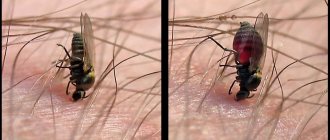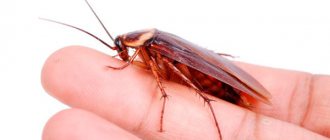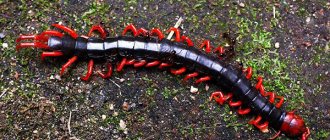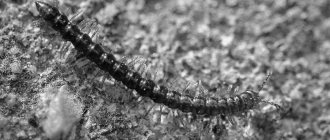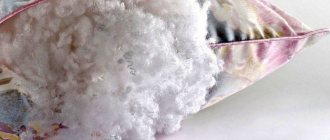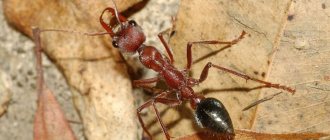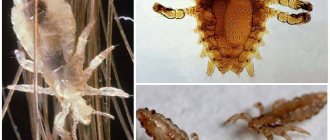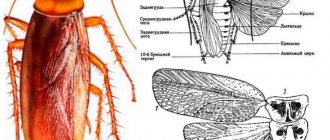The little midge is vile. Description of insects, habitat, characteristics of species, danger to humans. Can a midge bite? Why are blood-sucking bites dangerous? What actions need to be taken after a midge attack. How to prevent the development of serious consequences. Tips and tricks.
If you are planning to go to the forest to pick mushrooms, berries, or hunt, you need to be prepared for anything. You may have to spend the night in the forest, or you may meet a forest predator. In addition, there is a risk of being bitten by midges.
Below we will tell you what types of midges can attack you, what dangers can warn you when bitten, how to provide first aid and protect yourself with folk remedies and chemicals.
What is gnus
The midge is a small insect whose characteristics include the ability to mass attack a person or animal to consume blood. This species includes insects such as:
- mosquitoes;
- midges;
- horseflies;
- biting midges;
- mosquitoes.
In addition, the vile complex includes blood-sucking flies - tsetse, autumn flies. The presented species of parasites are found in different regions, regardless of climate - tundra, desert, temperate and tropical forests. In the photo you can see what they look like.
The maximum number of aggressive midges is concentrated in Siberia and Karelia. It is in these regions that the reason for the extinction of farm livestock (in the number of many thousands) and the cessation of logging-type enterprises lies in small blood-sucking insects.
What does a midge look like: photo
In the form of a cloud, the midges look like a swarm without a specific organization, which, changing shape, seems to roll in the air. Looking at how the midges look in the photo, especially in the taiga regions, sometimes it becomes creepy, but the number, persistence and voraciousness of insects in different areas can vary greatly, as well as the species diversity of pests that may be part of the midges.
Mosquito
The mosquito is one of the most common insects, which are classified as blood-sucking insects. Their number is more than 3 thousand species. The favorite places of mosquitoes are places characterized by high levels of humidity, as well as areas where there are stagnant bodies of water.
Such conditions are perfect for female mosquitoes to lay eggs, as well as for the full and unhindered development of their offspring.
Mosquito activity begins in May and lasts until September-October. Since the larvae of these pests are able to tolerate winter cold well, they can easily continue to actively develop and reproduce with the onset of spring.
Male mosquitoes eat plant foods, but females cannot reproduce without blood. Note that this type of insect is a carrier of dangerous infections, including yellow fever and malaria.
Midge
The midge is a small midge, characterized by high numbers. The taiga region alone has more than 1.9 thousand species of midges. Midges develop within an aquatic environment, which is why they are not found in dry, desert areas.
Most often, midges accumulate near open bodies of water, swampy meadows, and forests. It is almost impossible to find midges in well-ventilated areas and dry climates.
In appearance, the midge is a small parasite whose body length does not exceed four to five millimeters. Females eat human or animal blood.
When bitten, the skin is gnawed, which causes the person to experience rather unpleasant painful sensations and swelling may occur. Swelling as a result of a bite can be observed for several days. Moreover, bites are often accompanied by an allergic reaction.
The blood-sucking pest can act as a carrier of diseases that lead to death - plague, anthrax, tularemia.
Symptoms of a midge bite
The first thing a person who has been bitten by a midge feels is that the bite site begins to itch . Along with this, a burning sensation begins. After 10-30 minutes, the bite site swells, turning into a large red spot.
If the body reacts strongly to toxins and poisons, an allergic reaction may begin with the symptoms listed above.
The best advice is not to scratch the bite area . And it’s quite easy for adults to do this. But children cannot control themselves, therefore, if a child is bitten by midges, it is the parents who must ensure that the bite site is untouchable. It’s even better to use one of the ways to relieve itching, which we’ll talk about below.
Horseflies
Today, more than 5 thousand species of blood-sucking parasites such as horse flies are known, and 500 are found in Russia. For habitat they choose fresh water bodies, forests, and fields. Most often, they accumulate in large quantities in places where cattle graze.
The most common types of horseflies are parasites such as lacewings, rainflies, and bullflies.
In appearance, the horsefly resembles a large fly. The bite is carried out through a proboscis, with which the parasite pierces the skin of people or warm-blooded animals, while it injects a substance that stops blood clotting.
As a result, the wound after the bite is accompanied by prolonged pain and bleeding. Severe swelling, redness, and burning are also observed.
Getting to know the insect
Midges are small insects whose size barely reaches 5 mm. Most species have completely miniature sizes - 2 mm. They live everywhere, with the exception of Antarctica. All phases of development, until the insect reaches the imago stage, midges spend in an introductory environment. The family has about 1,800 species; the European temperate climate is inhabited mainly by fruit flies, whiteflies, and sciarids. Only a knowledgeable entomologist can determine the differences between them. The poor fellow, bitten by a midge, has no time to determine the species, and all the vileness looks the same to him.
Midges
Interesting!
In most species, only female midges feed on the blood of warm-blooded insects. Males eat exclusively fruit or flower nectar.
People who live near bodies of water or travelers in the taiga and tundra are most aware of how midges bite. As experienced people say, a midge in the taiga will be worse than a mosquito. Hordes of insects are called nothing more than midges. Rivers and lakes with running water are mandatory conditions for the reproduction of insects. Females lay their eggs on plant stems and stones in ponds. Some individuals specifically go underwater to lay offspring. Other females do not bother themselves with diving skills and drop their eggs on the fly. If you take a portion of water from the bottom of a river or any other body of water, using a magnifying glass you can see tiny worm-like white larvae.
The peak of activity begins in mid-April, early May and ends only by the end of June. In the northern regions, midge activity decreases after snowfall. Insects feed only during the daytime in sunny weather. On a rainy, cloudy day, no midge activity was recorded at night. Insects live in flocks containing myriads of individuals. People and animals suffer from midge bites. There are known cases where tens of thousands of cattle died from attacks by the Colombian midge in the Danube countries.
Midges
Review
“One day in late spring, my family and I came to visit relatives living on the banks of the small river Khoper. Suspecting nothing, we decided to get out into nature and relax on the river bank. We drove up to the shore and, inspired by the view of the spring landscape, quickly got out of the car. And then it started! Swarms of small midges swarmed around us and began to bite us furiously, tiny insects getting into our mouths and noses. The child immediately ran into the car, and we adults still tried to resist. But neither running fast nor waving branches helped. I had to leave the inhospitable shore; it’s good that at least no one was allergic to the midge bite. Local residents then laughed at us and said that the midge would disappear only after the flood and the June haymaking.”
Valentina Vladimirovna, Balashov
Mokretsy
Midges are small mosquitoes, their length reaches no more than 1-4 millimeters. In total, there are approximately 4 thousand species of biting midges, 500 of them live in Russia.
The female lays eggs and offspring on top of leaves and stems that grow from moist soil, sand, in forests, and near the shores of reservoirs (both fresh and salt). Both sexes of insects consume the blood of humans, a warm-blooded animal, as food.
When bitten, a substance with toxic components is injected, which causes the victim to experience severe allergies, pain, itching, and burning.
Tsetse fly
They know firsthand what vileness is in Africa. The country is home to many species of blood-sucking insects, including tsetse. The creature, measuring from 10 to 15 millimeters, suffers from a fatal disease - sleeping sickness. In 1990, 34,000 people died because of it.
The insect is common in equatorial and subequatorial Africa. Found in large river valleys and tropical rainforests. It attacks moving objects that emit heat and can even attack cars. For some reason the fly doesn't bother the zebras.
Tsetse can be recognized by its long and hard proboscis at the bottom of its head and the characteristic folding of its wings on top of each other. From the front of the fly's head extend small spines that are covered with short hairs. The color of the insect is brown-gray, the abdomen is yellow above and gray below. Both males and females feed on blood.
Mosquitoes
The mosquito is another species of midge that lives in tropical and subtropical climates, but is very rarely found in temperate climates. They are small in size, approximately 3-4 millimeters in length. They are characterized by slow movement and fly silently. Activation takes place at night.
Male mosquitoes consume plant nectar, but females must receive blood to be able to lay eggs.
A mosquito bite is accompanied by symptoms such as burning, itching, rashes, and painful pustules appear.
Where does the vile live?
The distribution of midges covers almost the entire globe, but, as mentioned above, in different climatic zones its composition can vary dramatically. The main environment where midges live in Russia is forests and tundra. Insects especially love swampy, damp areas and areas, since most larvae require a moist environment to develop. In the south of Russia and on the Black Sea coast, where the subtropical climate zone is located, midges also exist. It may include mosquitoes, horseflies and other insects typical of these areas
Blood-sucking flies
Blood-sucking flies live in the North and other regions. In appearance they resemble an ordinary housefly, but they use animal blood as food. Among the most common varieties is the autumn fly.
The parasite's oral apparatus has a special proboscis, distinguished by the presence of sharp serrations, with the help of which skin is torn off and blood is consumed. When a fly bites, it releases poison, which poses a risk of severe allergic reactions, itching, burning, and infection.
Both males and females consume blood. They can carry such dangerous diseases as tularemia, anthrax - depending on the species. their activity is observed from September to October.
The approximate lifespan of midges depends on the species and ranges from 3 days (midge) to 12 weeks (mosquito).
Types of midges
In the central region of the Russian Federation, the most common varieties of midges are:
- Midge;
- Mosquitoes;
- Burner fly;
- Mokrets;
- Horsefly;
- Mosquito;
- Deer bloodsucker.
In each of the listed insect species, there may be several dozen more subspecies, and in total, about 800 varieties of midges can be found on the territory of our country. Despite such a wide variety of midges, all its varieties are united by the fact that such insects are a serious danger to animals and people, attacking them, feeding on their blood, and sometimes leading to death.
Consequences of a vile attack
These types of insects bite every exposed part on the body. Most often, they pay attention to the arms, legs, and face. Initially, a person will not feel any pain, since the vile saliva contains anesthetic substances.
After this, the victim experiences the following symptoms (table):
| Type of symptom | How it manifests itself |
| Primary symptoms | Severe burning and itching Redness at the site of the bite Pinpoint wounds are located in a chaotic manner (even a detailed examination does not reveal the possibility of a midge bite) Swelling of tissues (in case of a midge bite near the eyes, there is a risk of swelling of the entire face) The appearance of cancer, blisters in the affected areas |
| General symptoms | Enlarged lymph nodes Increase in temperature (up to 39 degrees) Change in blood pressure Increased heart rate The appearance of purulent inflammation on the skin |
Allergic reactions to midge bites occur due to the fact that saliva contains hemolyzing substances of a protein nature. Children may experience more severe initial symptoms than adults.
This can be explained as follows: when itching occurs, children try to remove the symptom by scratching. Because of this, an unpleasant result occurs in the form of increased swelling - the wound becomes infected with pathogenic microbes, which leads to a long healing process of the skin.
Rarely, the most dangerous consequence of a midge bite may occur - anaphylactic shock. Harm also manifests itself in the risk of being harmed by a blood-sucking insect that carries a dangerous infection.
The midge was the cause of the plague epidemic no less than the rat. The risk of infection is small, but still, it exists if you consume the blood of a sick animal, and then a person.
Animals and vile creatures
Photo by Dmitry SHCHANITSYN
In Taimyr, wild reindeer from small groups unite into huge herds that number tens and even hundreds of thousands of animals.
Keeping animals in such large herds significantly reduces their suffering from midges.
For animals located in the center of the herd are not attacked by insects, and deer located on the periphery of the herd and experiencing attack by midges gradually move towards the center, that is, there is a constant replacement of deer.
Animals that are not included in large herds migrate to the shores of the seas of the Arctic Ocean.
It is cooler there, colder strong winds blow and there are significantly fewer blood-sucking dipterous insects.
I had the opportunity to work for several years in Yamal, in the mountains of the Polar Urals. Here, deer escape from midges in a unique way: they rise to the tops of the mountains, where there are glaciers and dense snowfields. Here insects do not bother them.
Deer in these places stay in groups and remain until the wind blows. It serves as a signal for animals to go to pasture. However, as soon as the wind stops, the midge rises to the wing again.
The deer have no choice but to go again to the location of the glaciers and snowfields, where it is cool and insects do not bother them. This continues as long as there is a massive outbreak of blood-sucking insects.
How do other animals protect themselves from midges?
Moose have wet fur in the summer due to the secretion of grease. Blood-sucking insects die from contact with it: the grease clogs their respiratory pores. However, it is absent from the head and lower limbs.
Therefore, during the period of mass flight of midges, moose are forced to stand up to their bellies in water for a long time and often dip their heads in it.
Deer, red deer and other ungulates climb higher into the mountains onto open layways. The winds are stronger and cooler here.
Bears in mountainous areas hide from midges in caves. In flat places they take refuge from blood-sucking dipterous insects in dense young spruce forests, trying to settle in damper, cooler places.
Wolves hide in dense spruce forests, where they rest under spruce “paws” spreading low above the ground. Wolverines in mountainous areas take refuge in rock crevices and caves. During the period of mass flight of blood-sucking insects, arctic foxes are forced to sit out for a long time in the labyrinths of their dens.
During the midsummer season, hares in Taimyr dig holes on the southern slopes of the hills, which they use for shelter from pestering insects.
Animals that have holes - marmots, gophers, chipmunks, pikas, lemmings, voles, mice - tend to stay in their shelters longer. Sables and squirrels linger longer in tree hollows.
| Pixabay Photos |
Wild boars protect themselves from midges in a unique way. Males, females, and young animals take mud baths. They lie in them for a long time. Due to this, their body is covered with dried clay and silt, which does not allow bloodsuckers to drink their blood.
Female boars make large nests out of grass and forest debris for their piglets, where the offspring are reliably protected from hordes of blood-sucking dipterous insects.
Candidate of Biological Sciences N.N. Rukovsky described the following incident: “In the Sikhote-Alin Nature Reserve in the middle of summer, we climbed the Podnebesny ridge along one of its side forts.
When our small detachment left the broad-leaved Manchurian forests below, passed a strip of cedar and entered the zone of spruce and fir taiga, it was decided to take a break.
One of my companions, sitting down on a dead tree, stepped on a pile of dry leaves from last year, and suddenly a desperate squeak or squeal came from it and something moved in the foliage. When we tore it up, a frightened musk deer calf appeared.
He was so small that he could fit in the palms of his hands and, in my opinion, weighed no more than a kilogram. After examining the musk deer and making sure that its thin legs were intact, we put it under dead wood, sprinkled it with leaves and went to look for another place to rest: we couldn’t stay here, because the baby’s mother was somewhere nearby.
In the evening, on the way back, we visited this place - the musk deer under the dead wood was no longer there. So we learned that the mother musk deer, leaving to feed, covers the baby with leaves to protect it from feathered predators, and most importantly, from midges.”
On Yamal, during the mass summer of blood-sucking insects, I twice rafted on a small boat (kolganka) made by the Nenets, from the top to the mouth of the Nyda River.
During these travels, I often observed wild reindeer lying on sandy headlands, where, due to the wind, there were no large concentrations of blood-sucking insects. There were moose immersed deep in coastal waters with vegetation.
In the boat with me was a husky named London. There were no mosquitoes around when we sailed. However, as soon as we approached the sandy shore and left it, hordes of mosquitoes soon attacked me and London.
He quickly navigated the emerging situation: he hid under the roots of an upturned tree in a niche on the bank and watched me from there. He did not respond to my calls to leave. Only when I pushed the boat away from the shore did he quickly run out of cover and jump into it, knowing that it would be comfortable during the rafting.
Anatoly Mukhachev August 22, 2022 at 05:37
midge bite
The bites of such insects pose a serious danger to people and animals. Their saliva contains toxic components, which, when released into the victim’s blood, provoke severe itching, burning, inflammation and redness of the skin tissue.
It is worth remembering that a bite can cause allergic reactions, which can lead to complications. In such cases, the development of Quincke's edema and anaphylactic shock is possible.
Therefore, insect attacks should be taken seriously and the necessary measures should be taken to prevent complications that pose a danger not only to human health, but also to life.
Feeding midges
Considering that the midge consists of a variety of species of midges, mosquitoes and other insects, its nutrition is difficult to determine accurately and unambiguously. For example, as for mosquitoes, among these insects only females feed on blood, and they do this during the breeding season. Among other insects that make up the midges, a similar trend is observed, because they also actively feed during the breeding season. Nevertheless, some types of food of those insects that make up the midges are common to many of them, and among such food is:
- Animal excrement;
- Decaying organics;
- Young shoots and leaves;;
- Juice of various plants;
- Mold;
- Mushrooms.
Some species of midges, which are part of the midges, feed not just on blood, but also on flesh. Therefore, upon closer examination, the wounds from a midge bite appear as depressions, with ragged edges, as if the skin and flesh had been torn out by teeth.
Elimination of swelling in the eyes
There may be situations where the midge bites in the eye area. This results in swelling of the upper eyelid, but it is also possible for the swelling to spread down the entire face. In addition to swelling, a person is bothered by severe pain, it seems that there is a foreign body in the eye, and the eye is very watery.
When a person experiences these symptoms, the following measures should be taken:
- Rinse the affected area with plenty of cold water.
- Apply a cold compress.
- Take any antihistamine, for example, Suprastin, Claritin, Fenistil drops, be sure to follow the dosage.
- Use eyelid ointment.
Use the ointment with extreme caution so that the drug does not get into the eye or mucous membranes; apply a thin layer to the eyelid. You can use ointments such as Nezulin, Fenistil, Psilo-balm.
If the swelling is too severe, your doctor will likely recommend using hormonal ointments, such as hydrocortisone or prednisolone. But remember, in this case you cannot self-medicate, since you can harm yourself even more; seeing a doctor is a mandatory procedure.
When swelling is accompanied by severe pain, you can take painkillers. It is recommended to take paracetamol or ibuprofen, as they have an anti-inflammatory effect.
Remember that it is prohibited to use creams, ointments, solutions for wiping or compresses that contain alcohol or vinegar, since these substances penetrate through thin skin, which leads to irritation and aggravates the situation.
If a midge bites a child
Midge bite in a child's eye
Children are more susceptible to various insect bites. Whether it be bites from mosquitoes, ticks or bed bugs. If a midge has bitten a child, also in the eye, then it is better to immediately contact a doctor.
If you are far from medical facilities, you can use the tips above. And the main thing to remember is that an allergic reaction in a child is observed more often than in adults , since the body is still weak and unaccustomed to various kinds of toxins and poisons.
Treatment of a mosquito bite
In order to prevent complications and relieve unpleasant symptoms from bites, treatment should be started immediately. Quite effective folk remedies that help reduce swelling, relieve itching, burning and pain.
To treat the affected area, you can prepare the following solutions:
- Mix ammonia and water in equal quantities.
- Take 1 glass of water and add ½ teaspoon of soda, stir thoroughly until completely dissolved.
- Take a glass of water and add ½ teaspoon each of salt and soda, stir thoroughly until completely dissolved.
These solutions should be used as follows: moisten cotton wool or a bandage in the solution, then apply to the affected area for 10-15 minutes.
To get rid of wounds, you can use calendula tincture, onion or lemon juice, mint, parsley, plantain, dandelion leaves, crushed cabbage leaves, and potato juice.
Now you can buy special ointments, creams, gels, of which there is a wide range on sale. These products have anti-allergenic, anti-inflammatory, anti-edematous effects. They help relieve itching, swelling and redness.
These drugs include:
- Trimistin.
- Hydrocortisone.
- Fenistil gel.
- Psilobalm.
- Levomekol.
- Tetracycline.
When a child is attacked by midges, the affected area must be covered with a clean, sterile bandage. Since the wounds are very itchy, a child can scratch it, and this can lead to bacteria. Also, during a blood-sucking attack, it is recommended to take an antihistamine, for example, Tavegil, Suprastin, Claritin.
Remember that if you experience severe symptoms that cause discomfort or pain, be sure to consult a doctor. The specialist will give directions for the necessary tests and prescribe effective, and most importantly safe, treatment. There is always a risk of developing a severe allergic reaction.
Prevention of bites
- Midges, like all insects, do not like rich odors. You can apply strong odors such as perfumes, antiperspirants, etc. around or directly on yourself.
- Midges are attracted to shiny and white things, so when traveling out of town to a pond, or into nature, it is better to avoid shiny fabrics and jewelry.
- It is also worth choosing carefully not only the color of the fabrics, but also the fabric itself. Experts recommend giving preference to natural fabrics such as cotton and linen during the period of blood-sucking activity.
- If you go out into nature, try to cover all parts of your body as much as possible: arms, legs, this will allow you to make sure that you are not bitten.
- Try to avoid grassy areas, especially near water bodies.
- It is also known that midges are especially active in the first half of the day and in hot weather. Therefore, plan your outings taking this data into account.
- If you nevertheless decide to relax on the shore of a pond on a hot day, it is recommended to use specialized repellents that repel insects (it is important to remember that some can only be applied to clothing).
- As you know, food smells attract not only hungry children and adults, but also harmful insects, which can pose a threat. So another recommendation would be to close the food in a special container that prevents attractive odors from spreading. Or even minimize eating in places where insects gather.
- In order to protect your home from midges, you need to use mosquito nets and air circulation devices.
- In the local area, the use of special spirals and lanterns will help get rid of insects.
In order for your favorite time of year to bring only positive emotions, you need to take a responsible approach to preparing for this period.
After all, when relaxing near bodies of water, in the forest, or even near the house, we are exposed to attacks by various insects.
But knowing how to protect yourself and your loved ones from unpleasant consequences, you can have fun during your holidays, holidays and active weekends. And if you do get bitten by midges, now you know what you need to do to ensure that it remains only a small nuisance and does not cause you much trouble.
First aid for a tumor
In order to prevent re-infection, as well as to prevent inflammatory processes, after an attack by midges, the affected area must be treated. Antiseptic agents can eliminate severe itching.
But before you get rid of the itching, you should resort to the following actions:
- At the first stage, you should wash the wound under running water, you can use antibacterial soap.
- Redness indicates an inflammatory process; antiseptic agents should be used. This can include products that contain alcohol, calendula, or citrus juice. If the attack occurred in nature and it is not possible to use any drugs, at the first stage you can wash the wound with your own saliva.
- Swelling and puffiness must be eliminated with cold compresses and ice.
- Now there are a large number of ointments, balms, creams that can relieve swelling.
- You can also use tincture of valerian and motherwort to treat the affected areas.
If these actions do not bring results, be sure to contact a doctor who will prescribe effective treatment.
How to get rid of a pest
There is no way to completely get rid of small blood suckers. These are inhabitants of wild nature who prefer areas near rivers and lakes, forests, fields, and the banks of swamps. But you can protect yourself from the attacks of these small pests.
If you are planning a trip to nature, where this blood-sucking midge most likely lives, you can use a special Antignus suit. Of course, you should use clothing that protects your body as much as possible.
This is a jacket with long sleeves and tight cuffs, a thick and tight collar, and tapered pants. To protect the head and faces, a hood and a mosquito net are used, but we all understand that such protective actions are relevant in the wild, and not in summer cottages and during outdoor recreation.
But in addition to clothing, which the midge cannot bite through, you can also use specialized products. When the holiday involves spending the night in a tent, a mosquito net is used, as well as specialized repellents. Nowadays you can buy a variety of repellents in the form of aerosols and creams.
Remember that when choosing a repellent, it is important to take into account what type of insect the drug is produced against. Also take into account age restrictions; special preparations are produced for children.
If we talk about the most popular products that have proven their effectiveness, it is worth noting Moskitol, Off, Taiga, Gardex, DEET.
Regarding folk remedies that make it possible to protect yourself from midges, one of the most effective is birch tar.
To do this, take birch tar and mix it with the same amount of sunflower oil, then use it as oil on open areas of the body. But remember that this product should be washed off with warm water 3-4 hours after application.
Methods of protection
Any vile is dangerous, there is no doubt that this is really the case, because its bites can cause a lot of inconvenience. Therefore, it is always worth using special protective equipment:
- repellent (available in the form of an aerosol, ointment or special lotion) that repels these insects well;
- a fumigant (available in aerosol or liquid form) that quickly gets rid of insects;
- special protective clothing.
If you need to treat an insect bite, you can use the following drugs:
- antihistamine type, if there is an allergy to the bite (for example, you can use suprastin);
- special for relieving the itching sensation after a bite, they can be purchased at any pharmacy.
Herbs and oils
Natural products that are also absolutely safe are very effective in combating symptoms.
Let's look at the most effective recipes that use aloe juice, plantain, basil and other natural products:
- Aloe. Aloe is very useful; if you have this medicinal plant, rest assured that it will prevent negative reactions to blood-sucking bites. You should cut the leaf and apply aloe pulp to the affected area. You can also use the juice of the plant; to do this, soak a cotton pad or a piece of bandage in it and apply it to the bite.
- Basil. We all know that this herb brings a lot of benefits to the body when used as food, but it will also save you from unpleasant symptoms, relieve inflammation, and eliminate itching and burning. To do this, take a few leaves and grind them into a paste, then apply it to the wound.
- Plantain. Everyone has been familiar with this plant since childhood; it was considered the remedy that would cure any wound. It is worth saying that plantain is truly a unique plant because it has anti-inflammatory and antiseptic effects, and also accelerates the healing process. You should take a leaf, grind it to a paste and apply it to the wound.
- Essential oils. In order to relieve swelling and get rid of itching, you should use lavender or tea tree essential oil. It is enough to apply a few drops to the affected area of the body.
Features of bloodsucker bites
As noted above, only females can bite. They need blood to mature their eggs. Midge bites are comparable to a surgical procedure. They do not pierce the skin, but literally gnaw it out, at the same moment the insects inject an anesthetic substance, which allows a person not to experience pain until the parasites have had their fill. At the same time, the annoying bloodsucker introduces an enzyme that prevents blood clotting.
The insect's saliva contains toxic substances for the human body, as a result of which swelling and redness, burning and severe itching appear at the site of the lesion. Numerous bites can cause fever, swelling of internal organs and, in rare cases, cause death.
Midge bite in the eye
The reaction to a midge bite varies from person to person and depends on age, pain threshold, number of lesions, and tendency to allergies. Severe itching causes the desire to scratch the areas caused by midge bites. Even an adult cannot resist this, let alone children who tear apart the affected areas until blood appears. As a result, the situation is aggravated by the penetration of bacteria. Photos of a midge bite are presented below.
